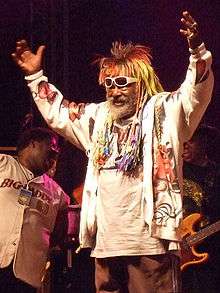Psychedelic funk
| Psychedelic funk | |
|---|---|
| Stylistic origins | |
| Cultural origins | Late 1960s |
| Derivative forms | |
| Fusion genres | |
Psychedelic funk (or funkadelia[1]) is a music genre that combines funk music with elements of psychedelic rock.[2] It was pioneered in the late 1960s by acts like Sly and the Family Stone and the Parliament-Funkadelic collective.[2][3] It would influence later styles including '70s jazz fusion and the '90s West Coast hip hop style G-funk.
History
Following the late 1960s work of Jimi Hendrix, the music and drug culture of psychedelia began to have a widespread impact on African American musicians.[4] Black funk artists such as Sly and the Family Stone borrowed techniques from psychedelic rock music, including wah pedals, fuzz boxes, echo chambers, and vocal distorters, as well as elements of blues rock and jazz.[2] Producer Norman Whitfield would draw on this sound on popular Motown recordings such as The Temptations' "Cloud Nine" and Marvin Gaye's "I Heard It Through the Grapevine."[3]

In the following years, groups such as Parliament-Funkadelic continued this sensibility, employing synthesizers and acid rock-oriented guitar work into open-ended funk jams.[3][2] According to theorist Kodwo Eshun, Clinton's work would focus more on the abject elements of psychedelia in contrast to earlier artists, and by the mid-1970s explored themes related to space and Afrofuturism.[1] In the early 1970s, jazz artists such as Miles Davis and Herbie Hancock combined elements of psychedelic funk with urban jazz to pioneer jazz fusion.[5][6]
Influence
Subsequent artists would be influenced by the style including Prince.[3] New wave band Talking Heads explored psychedelic funk, influenced by George Clinton, on a trilogy of acclaimed albums in the late 1970s.[7] In the 1990s, a popular psychedelic funk style known as G-funk emerged from the West Coast hip hop scene, represented by Warren G, Dr. Dre, and Snoop Dogg.[8] The 1990s hip hop duo OutKast were also influenced by black psychedelic musicians such as Sly Stone and Clinton.[9]
In recent years, examples of psychedelic funk from world music scenes have been collected on compilations issued on the World Psychedelic Funk Classics label.[10]
References
- 1 2 Echard, William (2017). Psychedelic Popular Music: A History through Musical Topic Theory. Indiana University Press. pp. 123–125. Retrieved 26 January 2018.
- 1 2 3 4 Scott, Derek B. "Dayton Street Funk: The Layering of Musical Identities". The Ashgate Research Companion to Popular Musicology. p. 275. Retrieved 25 November 2016.
- 1 2 3 4 Edmondson, Jacqueline (2013). Music in American Life: An Encyclopedia of the Songs, Styles, Stars, and Stories that Shaped our Culture [4 volumes]: An Encyclopedia of the Songs, Styles, Stars, and Stories That Shaped Our Culture. ABC-CLIO. p. 474.
- ↑ "Psychedelic soul", Allmusic, retrieved 27 February 2017.
- ↑ Lien, James (September 1997). "In the Bins". CMJ New Music Monthly (No. 49). CMJ Network.
- ↑ Dean, Matt (December 29, 2011). The Drum: A History. Scarecrow Press. p. 292.
- ↑ Reynolds, Simon (2005). Rip It Up and Start Again: Postpunk 1978-1984. Penguin. p. 163.
|access-date=requires|url=(help) - ↑ Hunter, Christopher. "WARREN G IS RELEASING A DOCUMENTARY ON THE HISTORY OF G-FUNK". XXL Mag. Missing or empty
|url=(help);|access-date=requires|url=(help) - ↑ "Outkast". Rolling Stone.
- ↑ All Music Various Artists, Psych-Funk Sa-Re-Ga! Seminar: Aesthetic Expressions of Psychedelic Funk Music in India 1970-1983, AllMusic Review by John Bush